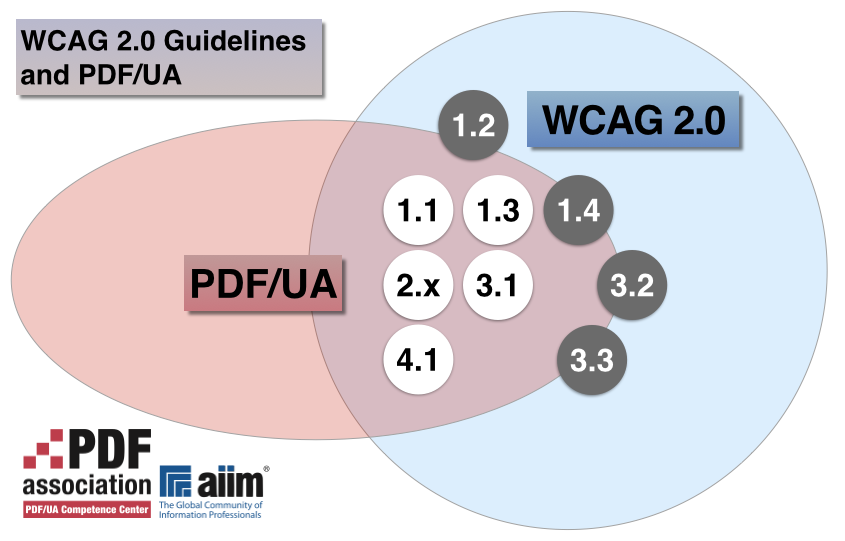
Infographics: PDF/UA and WCAG 2.0
A set of Venn diagrams explaining the relationship between WCAG 2.0, PDF/UA and the recent Section 508 refresh NPRM.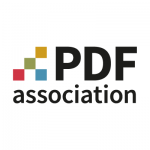
Following publication of PDF/UA in the summer of 2012, AIIMs US Committee for PDF/UA published a mapping between WCAG 2.0 Success Criteria and PDF/UA to help guide policy makers, software developers and authors consider their responsibility for various parameters of WCAG 2.0 conformance in a PDF/UA context.
As the first in a series of articles comparing WCAG 2.0 and PDF/UA we start with a graphical explanation of coverage from the WCAG 2.0 Success Criteria point of view. In a later piece we'll examine WCAG 2.0's coverage of PDF/UA's clauses.
The following Venn diagrams were developed with the approval of the PDF Associations PDF/UA Competence Center and AIIMs US Committee for PDF/UA to provide a graphical explanation for the relationship between PDF/UA and WCAG 2.0's Guidelines.
WCAG 2.0's Success Criteria are organized into twelve Guidelines derived from four Principles. Since WCAG 2.0 is technology-neutral it is also necessarily very general, and requires mapping, interpretation and application, especially to non-Web technologies.
The relationship between WCAG 2.0's twelve Guidelines and PDF/UA is expressed in this diagram:
The diagram shows that although WCAG 2.0 and PDF/UA address substantially different domains there is substantial overlap in terms of WCAG 2.0 Guidelines.
What's different about WCAG 2.0 and PDF/UA? The former is very high-level and general in the Principles and (to a lesses extent) in the Guidelines, with the most specifics in the Success Criteria.
Most WCAG 2.0 Guidelines are addressed - in PDF terms - within PDF/UA. Four Guidelines are partially addressed - the so-called "delta" between the two standards.
The four partially-addressed Guidelines are:
- 1.2 Time-based media
- 1.4 Distinguishable
- 3.2 Predictable
- 3.3 Input assistance
Most of the divergence is limited to a very specific set of content types.
PDF/UA and Time-based media
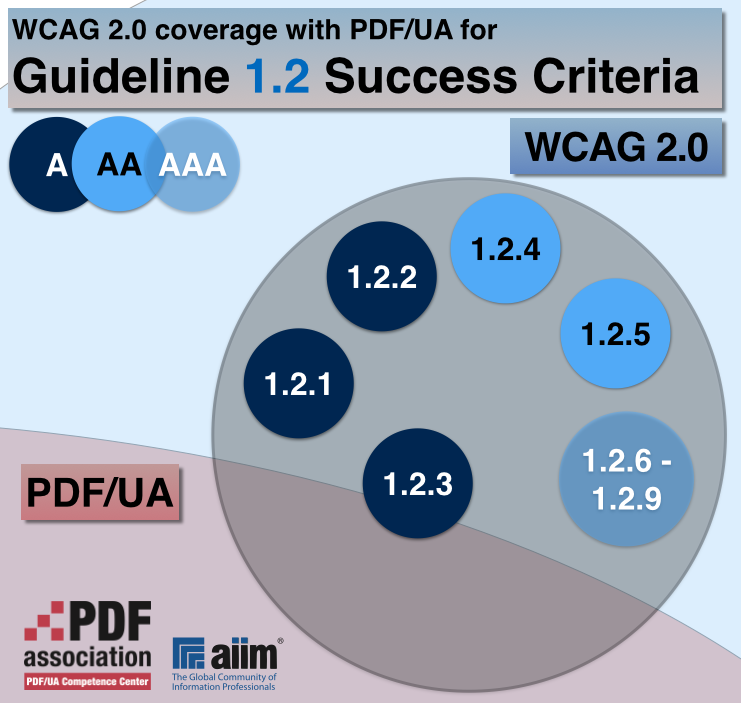 PDF/UA is focussed on the PDF document format, and addresses only in a peripheral way the many varieties of 3rd party content that users can (but rarely do) embed into PDF documents.
PDF/UA is focussed on the PDF document format, and addresses only in a peripheral way the many varieties of 3rd party content that users can (but rarely do) embed into PDF documents.
Accordingly, PDF/UA includes only the most minimal of normative requirements for time-based media. Essentially, PDF/UA's requirements are limited to requiring that multimedia files include a text description.
For software, PDF/UA requires conforming readers provide accessible controls (if controls are provided at all), and disallows automatic playback.
The WCAG 2.0 coverage with PDF/UA for Guideline 1.2 Success Criteria diagram shows that of the Success Criteria in Guideline 1.2 only 1.2.3 is partially addressed in PDF/UA.
PDF/UA and Distinguishable content
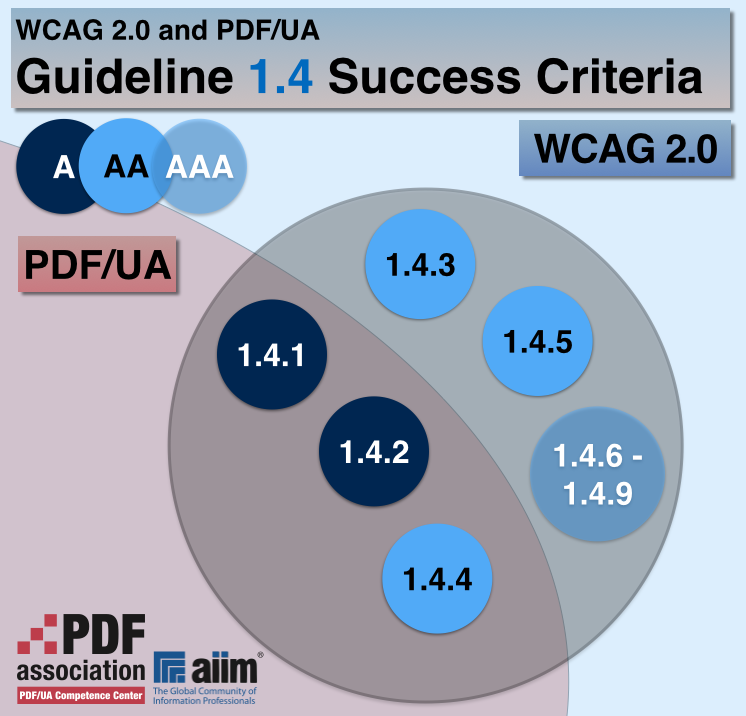 WCAG 2.0 establishes success criteria for assessing accessibility in web content whereas PDF/UA establishes requirements for assessing accessible use of the PDF format.
WCAG 2.0 establishes success criteria for assessing accessibility in web content whereas PDF/UA establishes requirements for assessing accessible use of the PDF format.
This distinction is fundamental to understanding the different ways in which the two standards approach the question of distinguishable content. PDF/UA's focus is to ensure that information can be made accessible by way of the Tagged PDF feature, whereas WCAG 2.0 assumes far more control over the appearance of any given element of content.
The WCAG 2.0 coverage with PDF/UA for Guideline 1.4 Success Criteria diagram shows that Success Criteria 1.4.1, 1.4.2 and 1.4.4 are fully addressed in PDF/UA. Success Criteria 1.4.3 and 1.4.5 through 1.4.9 are not addressed in PDF/UA at all.
PDF/UA and Predictable content
 Most provisions in 3.2 and 3.2 pertain to the operation of scripts.
Most provisions in 3.2 and 3.2 pertain to the operation of scripts.
JavaScript is used in many PDF documents, especially forms, to provide various logical, navigational and other functionality, including accessibility enhancements.
Nonetheless, PDF/UA is, as noted above, a PDF-specific standard, and requirements for JavaScript within PDF/UA are narrowly focussed, especially as compared to WCAG 2.0 Guideline 3.2 and 3.3.
The WCAG 2.0 coverage with PDF/UA for Guideline 3.2 Success Criteria diagram shows that Success Criteria 3.2.2 and 3.2.2 are partially addressed in PDF/UA. Success Criteria 3.2.3 through 3.2.5 are not addressed in PDF/UA at all.
PDF/UA and Input assistance
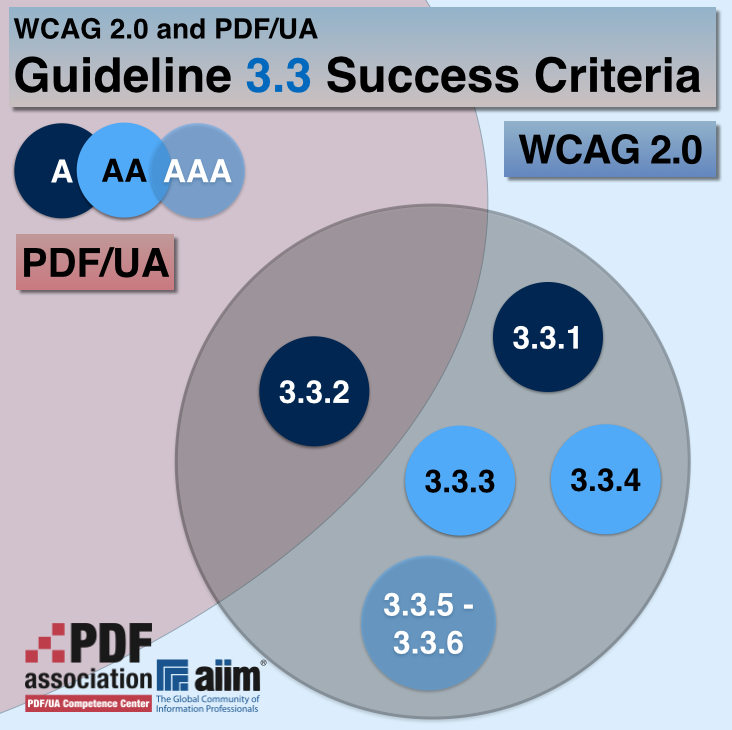 Most of Guideline 3.3 is, from the PDF perspective, a matter for the author to consider when designing their document, and therefore isn't PDF-specific.
Most of Guideline 3.3 is, from the PDF perspective, a matter for the author to consider when designing their document, and therefore isn't PDF-specific.
As stated in Achieving 2.0 with PDF/UA, in general, PDF/UA does not address visual appearance, content or design choices and relies on semantic equivalents. In these cases, PDF/UA generally refers implementers, normatively and informatively, to WCAG 2.0.
The WCAG 2.0 coverage with PDF/UA for Guideline 3.3 Success Criteria diagram shows that Success Criteria 3.3.2 is fully addressed in PDF/UA, but 3.3.1 and 3.3.3 through 3.3.6 are not addressed in PDF/UA at all.
PDF/UA, WCAG 2.0 and the 2015-02-18 Section 508 NPRM
The relationship between the standards at the level of WCAG 2.0 Guidelines is more complex if one overlays the US Access Board's new NPRM, which addresses not only content but the systems used to read it.
The NPRM text is WCAG 2.0-centric, and excludes level AAA's success criteria Success Criteria. Beyond WCAG 2.0 the NPRM includes requirements in §502 for "Interoperability with Assistive Technology) that PDF/UA shares (in its clause 8) but that WCAG 2.0 only informs. The NPRM specifically excludes requirements for assistive technology, which is the purpose of PDF/UA's clause 9.





